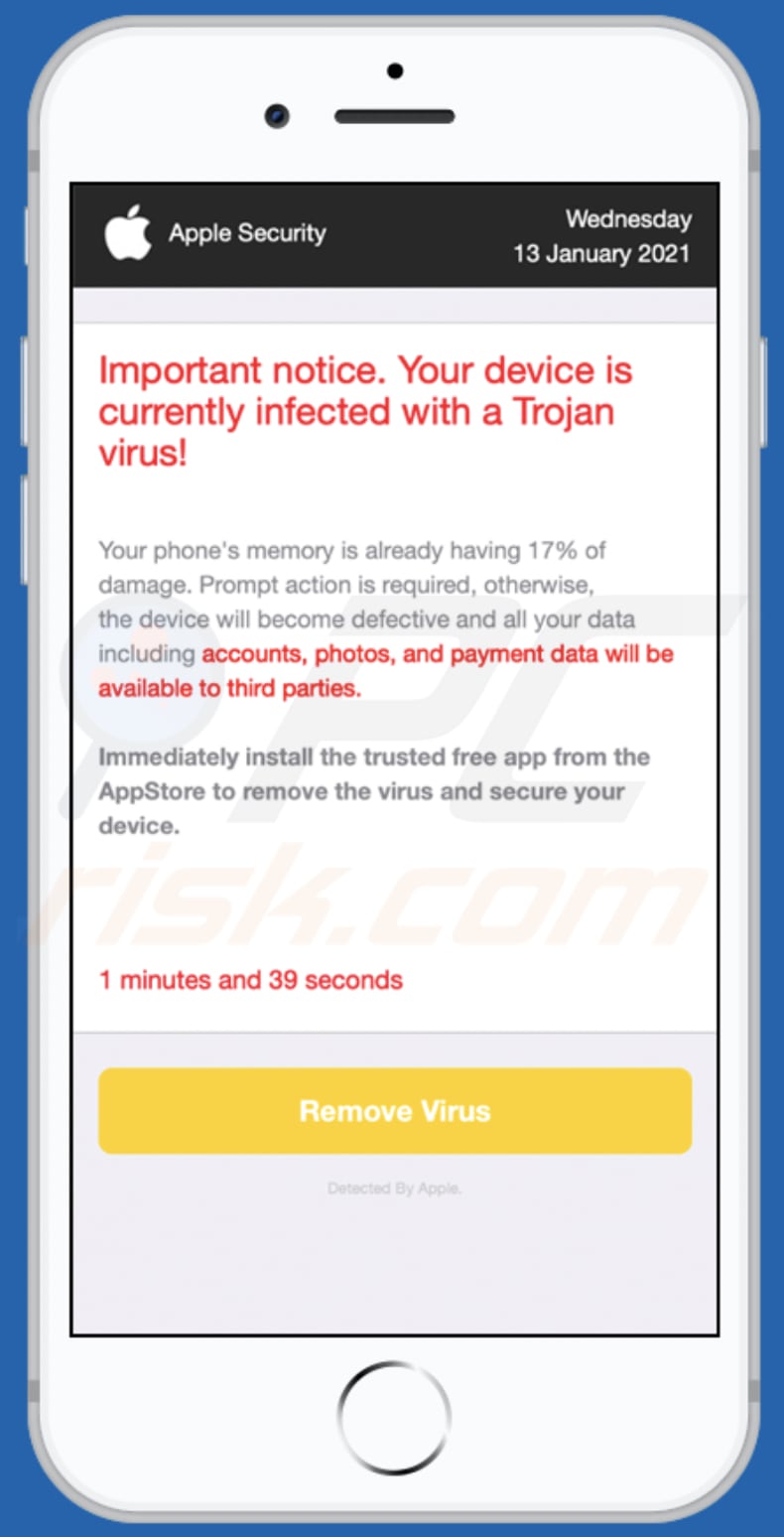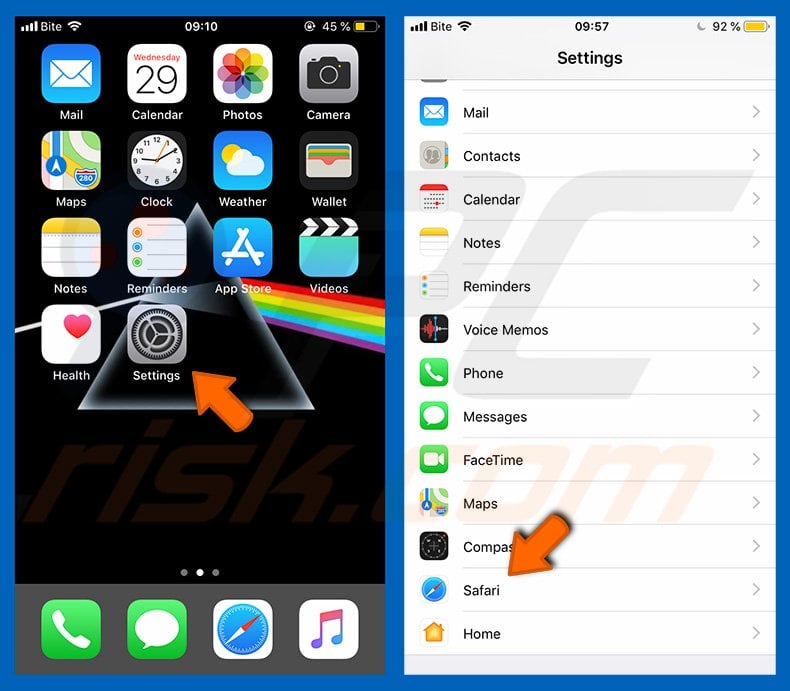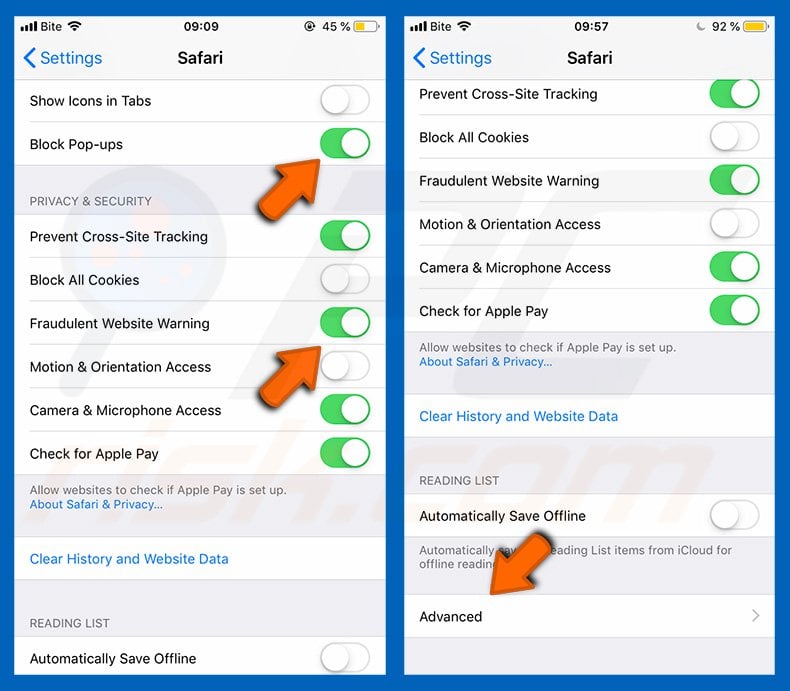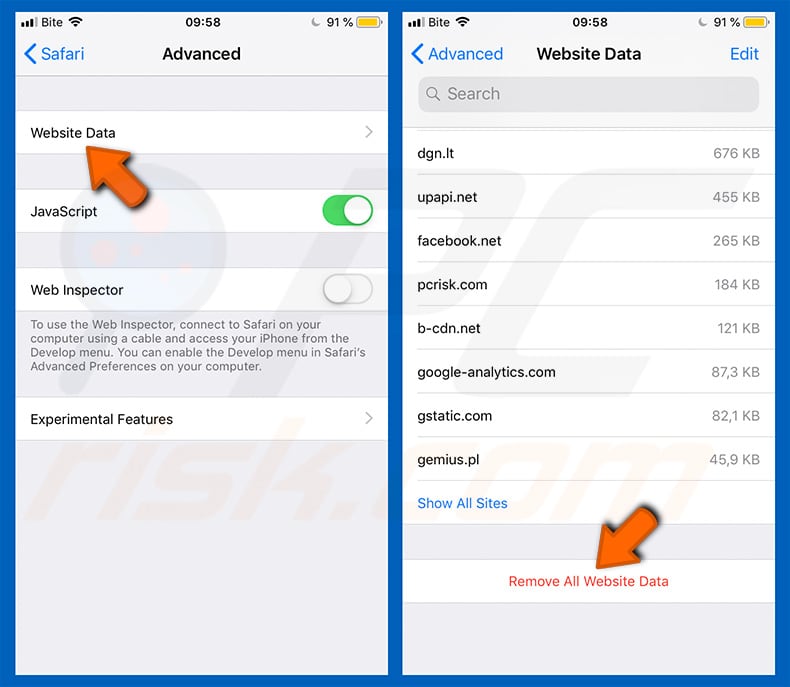How to remove apps designed to open landingsecure.com?
Mac VirusAlso Known As: landingsecure.com pop-up
Get free scan and check if your device is infected.
Remove it nowTo use full-featured product, you have to purchase a license for Combo Cleaner. Seven days free trial available. Combo Cleaner is owned and operated by RCS LT, the parent company of PCRisk.com.
What is landingsecure[.]com?
Landingsecure[.]com is a deceptive website used to scare its visitors into downloading and installing a certain potentially unwanted application (PUA).
Usually, websites like landingsecure[.]com display fake virus or error notifications, messages encouraging visitors to solve the problem (remove fake viruses, fix fake errors) with the offered application as soon as possible.
It is important to mention that users do not visit pages like landingsecure[.]com intentionally. Most of them are promoted through shady advertisements, other untrustworthy websites, and (or) potentially unwanted applications (PUAs).
![landingsecure[.]com scam](/images/stories/screenshots202104/landingsecure-com-pop-up-scam-main.jpg)
Landingsecure[.]com shows a fake system notification claiming that a device (iPhone) has been compromised. In the background, it displays a fake virus message claiming that a device is infected with a Trojan, and seventeen percent of its memory is damaged.
The main purpose of the landingsecure[.]com page is to trick its visitors into believing that their device will become even more damaged and they will lose their accounts, photos, and payment data if they do not remove the detected virus immediately using the app that can be downloaded via "Remove Virus" button.
It is worthwhile to mention that websites like landingsecure[.]com can be used to advertise legitimate applications. However, it does not ever mean that the device is actually infected or there is another problem they have supposedly detected.
Although, it is possible that could pages like landingsecure[.]com could be used to trick users into installing adware, some browser hijacker, or even malicious application. In one way or another, it is strongly advisable against downloading software from websites like landingsecure[.]com.
Apps that often are used to promote pages like landingsecure[.]com are designed to serve advertisements and collect various information as well. Usually, they generate coupons, pop-ups, surveys, banners, or other ads. The bigger problem is that those ads usually advertise shady, potentially malicious pages.
In some cases, they can execute scripts designed to download or install unwanted software. Also, PUAs tend to be used as tools to collect IP addresses, entered search queries, geolocations, addresses of visited websites, and other browsing-related details.
In some cases, their developers design them to gather sensitive data. It is important to know that collected data gathered by PUAs could be sold to third parties (potentially cyber criminals) or misused to generate revenue in other ways.
Therefore, users who have some PUA installed on a browser or computer are likely to encounter issues related to privacy, browsing safety, and other problems.
| Name | landingsecure.com pop-up |
| Threat Type | Phishing, Scam, Mac malware, Mac virus |
| Fake Claim | Device is compromised (infected with a Trojan virus) |
| Serving IP Address | 167.71.172.5 |
| Symptoms | Your Mac becomes slower than normal, you see unwanted pop-up ads, you are redirected to dubious websites. |
| Distribution methods | Deceptive pop-up ads, free software installers (bundling), fake Flash Player installers, torrent file downloads. |
| Damage | Internet browser tracking (potential privacy issues), display of unwanted ads, redirects to dubious websites, loss of private information. |
| Malware Removal (Windows) |
To eliminate possible malware infections, scan your computer with legitimate antivirus software. Our security researchers recommend using Combo Cleaner. Download Combo CleanerTo use full-featured product, you have to purchase a license for Combo Cleaner. 7 days free trial available. Combo Cleaner is owned and operated by RCS LT, the parent company of PCRisk.com. |
Landingsecure[.]com is more or less similar to a great number of other websites that use the same tactic to trick visitors into downloading and installing potentially unwanted software. Some examples of pages similar to landingsecure[.]com are landoseseq[.]com, security-protect[.]systems, and yourlandsecurity[.]com.
It is important to mention that these pages are designed to display messages designed to look like notifications from the Apple websites or the iOS system. However, the actual Apple company (its websites, products, or services) have nothing to do with pages like landingsecure[.]com or the fake warnings they display.
How did potentially unwanted applications install on my computer?
It is common that potentially unwanted applications are distributed through downloaders and installers for other programs. This distribution method is known as "bundling". Developers bundle PUAs with other programs and hope that users will not decline offers to download or install them.
Typically, such offers can be found in "Custom", "Advanced", and other similar settings (or alongside checkboxes) that those downloaders, installers have. When users download or install programs without checking and changing any settings, they allow for any bundled applications to download or installed as well.
In some cases, users cause unintentional downloads or installations by clicking on deceptive advertisements that are designed to execute certain scripts. Usually, ads of this type appear on untrustworthy, potentially malicious sites.
How to avoid installation of potentially unwanted applications?
Programs and files should not be downloaded from unofficial pages, through third-party downloaders, Peer-to-Peer networks (e.g., torrent clients, eMule), or other sources of this kind or installed with third-party, unofficial installers.
Apps should should be downloaded, from official pages or legitimate platforms like App Store. Furthermore, downloads and installations should not be finished without checking downloaders and installers for "Advanced", "Custom", "Manual", and other settings, or checkboxes.
It is important to check downloaders and installers for bundled applications and opt them out (decline unwanted offers). Ads that appear on shady pages should not be clicked as well. They may be designed to cause downloads, installations of unwanted applications, or simply open other, potentially malicious sites.
All unknown, unwanted, suspicious extensions, plug-ins or add-ons installed on a browser (or programs of this kind installed on the operating system), should be uninstalled. If your computer is already infected with PUAs, we recommend running a scan with Combo Cleaner Antivirus for Windows to automatically eliminate them.
Text in the fake system message:
YOUR IPHONE HAS BEEN COMPROMISED
Immediate Action Is Required!
OK
Screenshot of the background page:

Text in this page:
Apple Security Wednesday
13 January 2021
Important notice. Your device is currently infected with a Trojan virus!
Your phone's memory is already having 17% of damage. Prompt action is required, otherwise,
the device will become defective and all your data including accounts, photos, and payment data will be available to third parties.Immediately install the trusted free app from the AppStore to remove the virus and secure your device.
1 minutes and 29 seconds
Remove Virus
Detected By Apple.
To enable pop-up blocking, fraudulent website warnings, and remove web browsing data in mobile Apple devices, follow these steps:
First, go to "Settings", and then scroll down to find and tap "Safari".

Check if the "Block Pop-ups" and "Fraudulent Website Warning" toggles are enabled. If not, enable them immediately. Then, scroll down and tap "Advanced".

Tap "Website Data" and then "Remove All Website Data".

Instant automatic malware removal:
Manual threat removal might be a lengthy and complicated process that requires advanced IT skills. Combo Cleaner is a professional automatic malware removal tool that is recommended to get rid of malware. Download it by clicking the button below:
DOWNLOAD Combo CleanerBy downloading any software listed on this website you agree to our Privacy Policy and Terms of Use. To use full-featured product, you have to purchase a license for Combo Cleaner. 7 days free trial available. Combo Cleaner is owned and operated by RCS LT, the parent company of PCRisk.com.
Quick menu:
- What is "landingsecure[.]com"?
- STEP 1. Remove PUA related files and folders from OSX.
- STEP 2. Remove rogue extensions from Safari.
- STEP 3. Remove rogue add-ons from Google Chrome.
- STEP 4. Remove potentially unwanted plug-ins from Mozilla Firefox.
Video showing how to remove adware and browser hijackers from a Mac computer:
Potentially unwanted applications removal:
Remove potentially unwanted applications from your "Applications" folder:

Click the Finder icon. In the Finder window, select "Applications". In the applications folder, look for "MPlayerX", "NicePlayer", or other suspicious applications and drag them to the Trash. After removing the potentially unwanted application(s) that cause online ads, scan your Mac for any remaining unwanted components.
DOWNLOAD remover for malware infections
Combo Cleaner checks if your computer is infected with malware. To use full-featured product, you have to purchase a license for Combo Cleaner. 7 days free trial available. Combo Cleaner is owned and operated by RCS LT, the parent company of PCRisk.com.
Remove adware-related files and folders

Click the Finder icon, from the menu bar. Choose Go, and click Go to Folder...
 Check for adware generated files in the /Library/LaunchAgents/ folder:
Check for adware generated files in the /Library/LaunchAgents/ folder:

In the Go to Folder... bar, type: /Library/LaunchAgents/

In the "LaunchAgents" folder, look for any recently-added suspicious files and move them to the Trash. Examples of files generated by adware - "installmac.AppRemoval.plist", "myppes.download.plist", "mykotlerino.ltvbit.plist", "kuklorest.update.plist", etc. Adware commonly installs several files with the exact same string.
 Check for adware generated files in the ~/Library/Application Support/ folder:
Check for adware generated files in the ~/Library/Application Support/ folder:

In the Go to Folder... bar, type: ~/Library/Application Support/

In the "Application Support" folder, look for any recently-added suspicious folders. For example, "MplayerX" or "NicePlayer", and move these folders to the Trash.
 Check for adware generated files in the ~/Library/LaunchAgents/ folder:
Check for adware generated files in the ~/Library/LaunchAgents/ folder:

In the Go to Folder... bar, type: ~/Library/LaunchAgents/

In the "LaunchAgents" folder, look for any recently-added suspicious files and move them to the Trash. Examples of files generated by adware - "installmac.AppRemoval.plist", "myppes.download.plist", "mykotlerino.ltvbit.plist", "kuklorest.update.plist", etc. Adware commonly installs several files with the exact same string.
 Check for adware generated files in the /Library/LaunchDaemons/ folder:
Check for adware generated files in the /Library/LaunchDaemons/ folder:

In the "Go to Folder..." bar, type: /Library/LaunchDaemons/

In the "LaunchDaemons" folder, look for recently-added suspicious files. For example "com.aoudad.net-preferences.plist", "com.myppes.net-preferences.plist", "com.kuklorest.net-preferences.plist", "com.avickUpd.plist", etc., and move them to the Trash.
 Scan your Mac with Combo Cleaner:
Scan your Mac with Combo Cleaner:
If you have followed all the steps correctly, your Mac should be clean of infections. To ensure your system is not infected, run a scan with Combo Cleaner Antivirus. Download it HERE. After downloading the file, double click combocleaner.dmg installer. In the opened window, drag and drop the Combo Cleaner icon on top of the Applications icon. Now open your launchpad and click on the Combo Cleaner icon. Wait until Combo Cleaner updates its virus definition database and click the "Start Combo Scan" button.

Combo Cleaner will scan your Mac for malware infections. If the antivirus scan displays "no threats found" - this means that you can continue with the removal guide; otherwise, it's recommended to remove any found infections before continuing.

After removing files and folders generated by the adware, continue to remove rogue extensions from your Internet browsers.
Remove malicious extensions from Internet browsers
 Remove malicious Safari extensions:
Remove malicious Safari extensions:

Open the Safari browser, from the menu bar, select "Safari" and click "Preferences...".

In the preferences window, select "Extensions" and look for any recently-installed suspicious extensions. When located, click the "Uninstall" button next to it/them. Note that you can safely uninstall all extensions from your Safari browser - none are crucial for regular browser operation.
- If you continue to have problems with browser redirects and unwanted advertisements - Reset Safari.
 Remove malicious extensions from Google Chrome:
Remove malicious extensions from Google Chrome:

Click the Chrome menu icon ![]() (at the top right corner of Google Chrome), select "More Tools" and click "Extensions". Locate all recently-installed suspicious extensions, select these entries and click "Remove".
(at the top right corner of Google Chrome), select "More Tools" and click "Extensions". Locate all recently-installed suspicious extensions, select these entries and click "Remove".

- If you continue to have problems with browser redirects and unwanted advertisements - Reset Google Chrome.
 Remove malicious extensions from Mozilla Firefox:
Remove malicious extensions from Mozilla Firefox:

Click the Firefox menu ![]() (at the top right corner of the main window) and select "Add-ons and themes". Click "Extensions", in the opened window locate all recently-installed suspicious extensions, click on the three dots and then click "Remove".
(at the top right corner of the main window) and select "Add-ons and themes". Click "Extensions", in the opened window locate all recently-installed suspicious extensions, click on the three dots and then click "Remove".

- If you continue to have problems with browser redirects and unwanted advertisements - Reset Mozilla Firefox.
Share:

Tomas Meskauskas
Expert security researcher, professional malware analyst
I am passionate about computer security and technology. I have an experience of over 10 years working in various companies related to computer technical issue solving and Internet security. I have been working as an author and editor for pcrisk.com since 2010. Follow me on Twitter and LinkedIn to stay informed about the latest online security threats.
PCrisk security portal is brought by a company RCS LT.
Joined forces of security researchers help educate computer users about the latest online security threats. More information about the company RCS LT.
Our malware removal guides are free. However, if you want to support us you can send us a donation.
DonatePCrisk security portal is brought by a company RCS LT.
Joined forces of security researchers help educate computer users about the latest online security threats. More information about the company RCS LT.
Our malware removal guides are free. However, if you want to support us you can send us a donation.
Donate
▼ Show Discussion